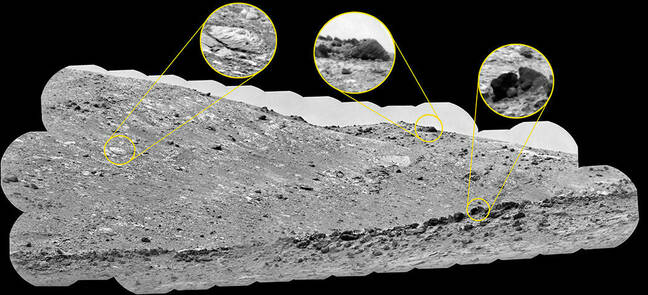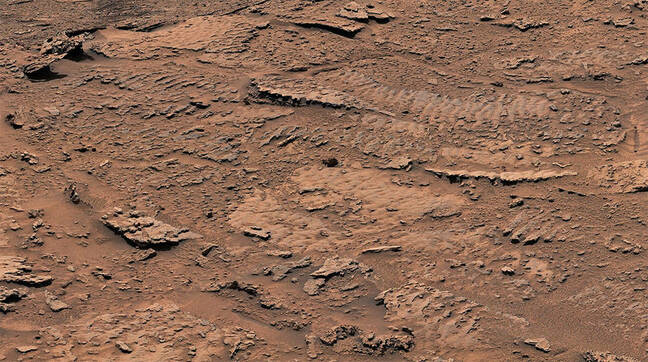This article is more than 1 year old
Curiosity finds clearest evidence yet for water on Mars
A rippled rocky ridge suggests the presence of lakes and waves, all at a higher elevation than expected
The Mars Curiosity rover has discovered what NASA said is its clearest evidence yet that the red planet used to be anything but dusty and dry - and it found that evidence in a place it didn't expect.
The discovery comes in the form of rocks covered in rippled patterns that Curiosity scientists discovered in photos the rover snapped in December of an area of incredibly dense, hard rock known as "Marker Band Valley."
Those ripples, NASA said, were formed as waves lapped the shores of an ancient shallow lake in the area. "Billions of years ago, waves on the surface … stirred up sediment at the lake bottom, over time creating rippled textures left in rock."
Ashwin Vasavada, Curiosity project scientist at NASA's Jet Propulsion Laboratory, said the sighting of such clear evidence for water - and waves - that high up in the region of Mars dubbed the sulfate-bearing unit (SBU) was quite the surprise.
"We climbed through thousands of feet of lake deposits and never saw evidence like this – and now we found it in a place we expected to be dry," Vasvada said.
Mars Rover: SBU
Curiosity had been on a course for the SBU, a region of the three-mile (5km) tall Mount Sharp, since landing on Mars because NASA's orbital observations in the early 2000's flagged the areas as having once been covered in water.
When it arrived in the area in October of last year and began to climb the mountain, NASA figured Curiosity was reaching the end of spotting evidence for the long-term presence of water, as the assumption had been that the SBU formed as Mars' climate was already beginning to dry out.
That supposition was supported by the discovery in the SBU of deposits of epsom salts, gypsum and plain old sodium chloride table salt, high concentrations of which suggest the last vestiges of mineral-rich water once occupied the area.
The marker band, where Curiosity has now arrived and where it found the dark, hard rippled rocks, is nearly a half-mile above the mountain's base - higher than researchers assumed there would have been enough water to form waves and disturb sediment in such regular, rhythmic patterns.
"The wave ripples, debris flows, and rhythmic layers all tell us that the story of wet-to-dry on Mars wasn't simple," Vasavada said.
The team said another set of nearby rocks that display a different ripple pattern look similar to Earth rocks buffeted by regular long-term periodic weather. In this case, it could be evidence of regular dust storms or other ancient weather patterns.
We reached out to NASA to learn more about how this discovery may change assumptions about Mars' evolution and will update this story when we hear back.
More water evidence? A landslide brought it down
Curiosity is a venerable machine in space exploration years - it's been operating on Mars since August 2012 and keeps trucking along - but even Curiosity has its limits, like reaching the upper regions of Mount Sharp, which NASA said the rover probably won't be able to do.
Mount Sharp, NASA said, is made of layers, and "as the rover ascends, it progresses along a Martian timeline, allowing scientists to study how Mars evolved from a planet that was more Earth-like in its ancient past, with a warmer climate and plentiful water, to the freezing desert it is today."
- Mars rover Curiosity reaches sulfate-rich Mount Sharp after 10-year journey
- Robot seal tested for stress relief on pretend Mars mission
- China's Mars rover hibernates for a scarily long time
- NASA boss says US may lose latest space race with China
Since it will be unable to reach the youngest upper reaches of Mount Sharp, clues into Mars' more recent past will be unreachable too, but luckily it looks like a landslide in nearby Gediz Vallis could help.

A ridge in Gediz Vallis where Curiosity believes wet landslides have displaced younger rocks into a reachable area - Click to enlarge
"Wind carved the valley, but a channel running through it that starts higher up on Mount Sharp is thought to have been eroded by a small river," NASA said. Because the erosion comes from high up the mountain, NASA believes the rocks sitting in Gediz Vallis - where Curiosity can reach them - will be some of the youngest it will ever get a chance to see.
It's now headed in that direction, but a rendezvous date hasn't been shared - NASA said it'll get there later this year, but between now and then another unexpected discovery could divert it toward some new, even more exciting goal. ®

